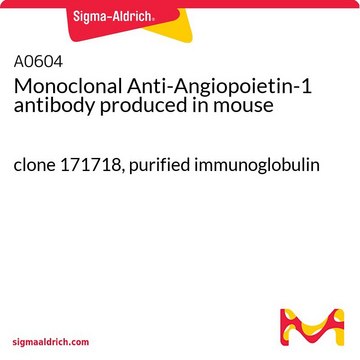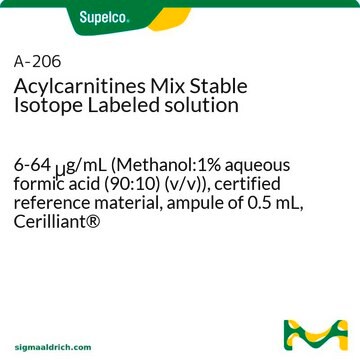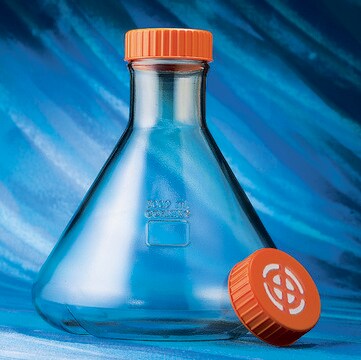A1104
Anti-Angiopoietin-1 antibody produced in goat
affinity isolated antibody, lyophilized powder
Synonym(s):
Anti-ANG-1
Sign Into View Organizational & Contract Pricing
All Photos(1)
About This Item
conjugate:
unconjugated
application:
ELISA (i)
IHC
WB
IHC
WB
clone:
polyclonal
species reactivity:
human
citations:
7
technique(s):
immunohistochemistry: 5-15 μg/mL using cells and tissues
indirect ELISA: 0.5-1.0 μg/mL
western blot: 0.1-0.2 μg/mL
indirect ELISA: 0.5-1.0 μg/mL
western blot: 0.1-0.2 μg/mL
Recommended Products
biological source
goat
Quality Level
recombinant
expressed in goat
conjugate
unconjugated
antibody form
affinity isolated antibody
antibody product type
primary antibodies
clone
polyclonal
form
lyophilized powder
species reactivity
human
technique(s)
immunohistochemistry: 5-15 μg/mL using cells and tissues
indirect ELISA: 0.5-1.0 μg/mL
western blot: 0.1-0.2 μg/mL
UniProt accession no.
storage temp.
−20°C
target post-translational modification
unmodified
Gene Information
human ... ANGPT1(284)
General description
Angiopoietin 1 is an endothelial cell-specific protein that is a ligand for the TIE2 tyrosine receptor. Angiopoietin 1 is critical for mature blood vessel formation.
Angiopoietin-1 (ANG-1) activates Tie-2 signaling in endothelial cells to promote chemotaxis, cell survival, cell sprouting, vessel growth, and stabilization,. ANG-1 is closely related to ANG-2. Both ANG-1 and ANG-2, with their receptor Tie-2, regulate embryonic vasculogenesis and angiogenisis, adult angiogenic sprouting, as well as endothelial cell proliferation.
Immunogen
purified, NSO-derived, recombinant human ANG-1.
Application
Goat anti-angiopoietin-1 can be used for immunohistochemistry (5-15 μg/mL), indirect ELISA (0.5-1.0 μg/mL) and western blot (0.1-0.2 μg/mL).
Physical form
Lyophilized from a 0.2 μm filtered solution in phosphate buffered saline with 5% trehalose
Disclaimer
Unless otherwise stated in our catalog or other company documentation accompanying the product(s), our products are intended for research use only and are not to be used for any other purpose, which includes but is not limited to, unauthorized commercial uses, in vitro diagnostic uses, ex vivo or in vivo therapeutic uses or any type of consumption or application to humans or animals.
Not finding the right product?
Try our Product Selector Tool.
recommended
Product No.
Description
Pricing
Storage Class Code
11 - Combustible Solids
WGK
WGK 3
Flash Point(F)
Not applicable
Flash Point(C)
Not applicable
Personal Protective Equipment
dust mask type N95 (US), Eyeshields, Gloves
Choose from one of the most recent versions:
Already Own This Product?
Find documentation for the products that you have recently purchased in the Document Library.
N Jones et al.
Nature reviews. Molecular cell biology, 2(4), 257-267 (2001-04-03)
Angiogenesis is required for normal embryonic vascular development and aberrant angiogenesis contributes to several diseases, including cancer, diabetes and tissue ischaemia. What are the molecular mechanisms that regulate this important process? The Tie family of receptors and their ligands, the
L M Orre et al.
Oncogene, 32(49), 5531-5540 (2013-06-12)
S100A4 is a small calcium-binding protein that is commonly overexpressed in a range of different tumor types, and it is widely accepted that S100A4 has an important role in the process of cancer metastasis. In vitro binding assays has shown
P C Maisonpierre et al.
Science (New York, N.Y.), 277(5322), 55-60 (1997-07-04)
Angiogenesis is thought to depend on a precise balance of positive and negative regulation. Angiopoietin-1 (Ang1) is an angiogenic factor that signals through the endothelial cell-specific Tie2 receptor tyrosine kinase. Like vascular endothelial growth factor, Ang1 is essential for normal
B Witzenbichler et al.
The Journal of biological chemistry, 273(29), 18514-18521 (1998-07-11)
Angiopoietin-1 and its putative natural antagonist, angiopoietin-2, were recently isolated, and the critical role of angiopoietin-1 in embryogenic angiogenesis was demonstrated by targeted gene disruption. Specific biological effects of angiopoietin-1, however, have yet to be defined. In this study we
Natalie R Leach et al.
Virology, 406(1), 127-137 (2010-08-03)
The nuclear lamina is thought to be a steric barrier to the herpesvirus capsid. Disruption of the lamina accompanied by phosphorylation of lamina proteins is a conserved feature of herpesvirus infection. In HSV-1-infected cells, protein kinase C (PKC) alpha and
Our team of scientists has experience in all areas of research including Life Science, Material Science, Chemical Synthesis, Chromatography, Analytical and many others.
Contact Technical Service








